Abstract
A linker PCR procedure has been developed for preparing repetitive DNA-free probes from genomic clones, which is especially efficient for members of gene families. Using this procedure as well as standard methods to prepare hybridization probes, chromosomal map positions of MADS-box genes were determined in recombinant inbred lines of maize (Zea mays ssp. mays). It appears that MADS-box genes are scattered throughout the maize genome. While there is evidence that this genomic distribution is representative for plant MADS-box genes in general, the following two other observations probably reflect Zea genome organization. First, at least one family of MADS-box-carrying elements contains line-specific versions, which are present in some maize lines at certain chromosomal positions, but are absent from these loci in other lines. The members of this family resemble transposable elements in some respects. Secondly, the finding of pairs of highly related MADS-box genes which are accompanied by other duplicated markers is a further indication of the ancestral polyploid genome constitution revealed with other markers. The importance of these findings for an understanding of the genomic organization of MADS-box genes and the evolution of the MADS-box gene family is discussed.
Full text
PDF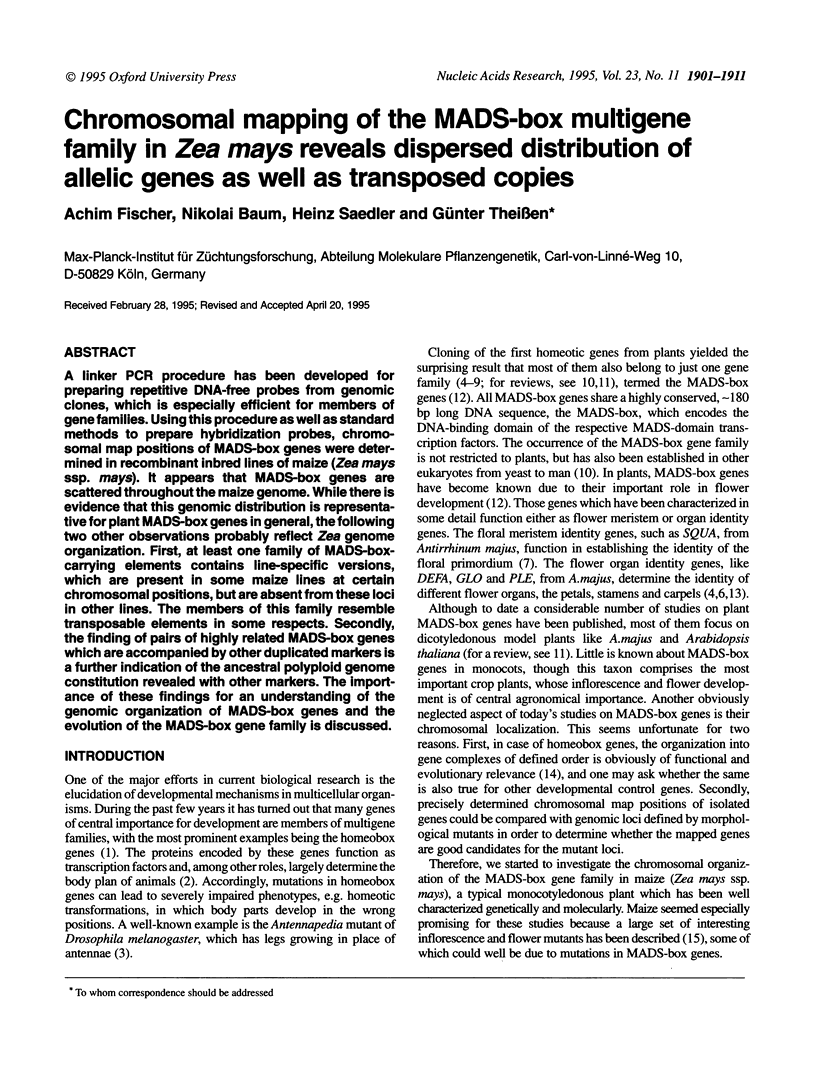

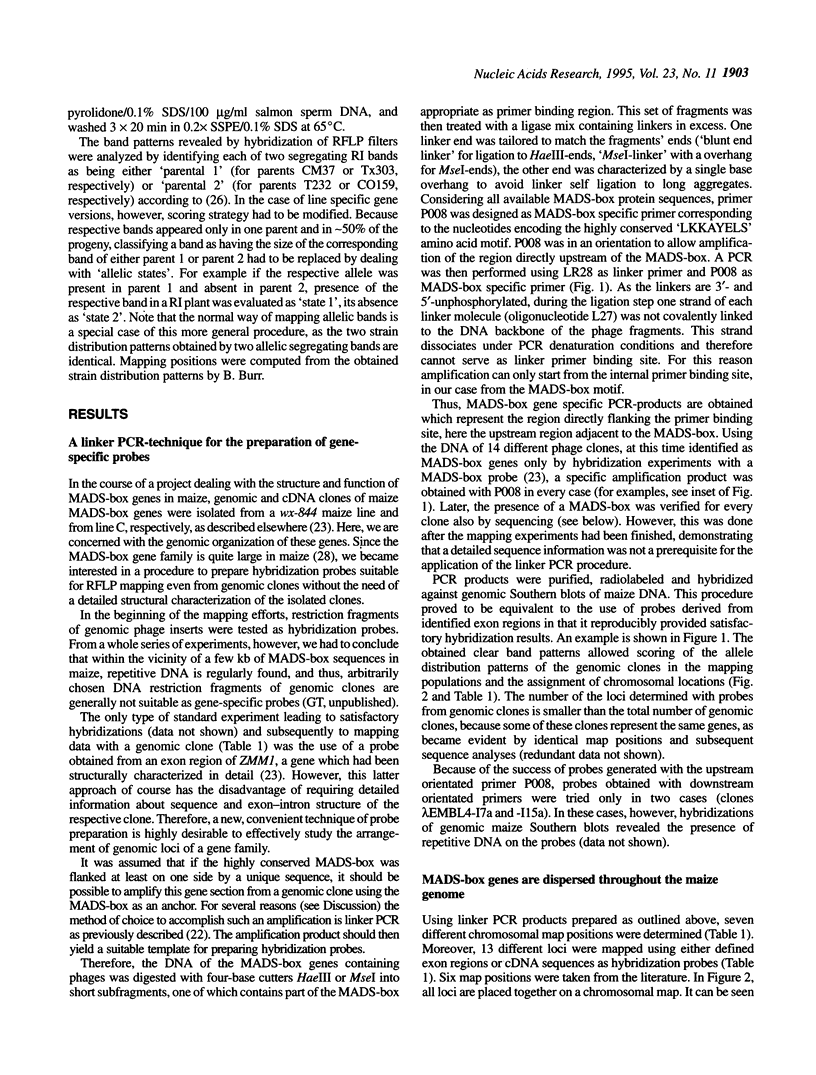
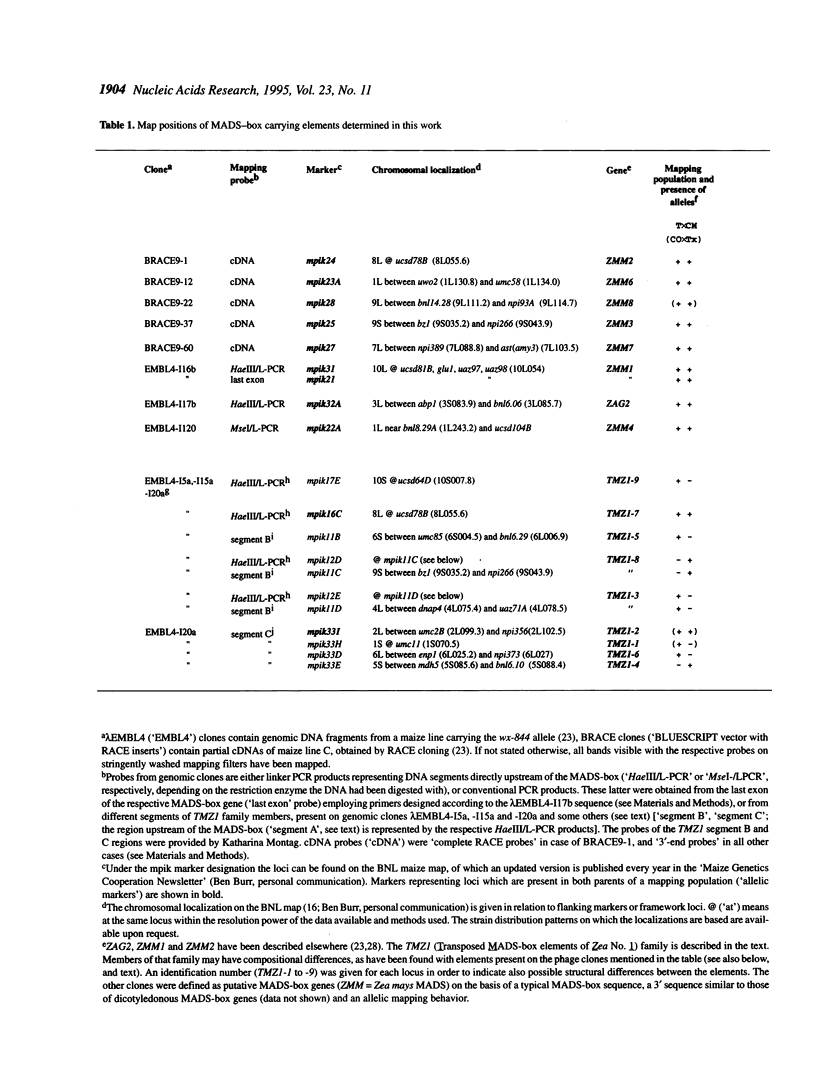
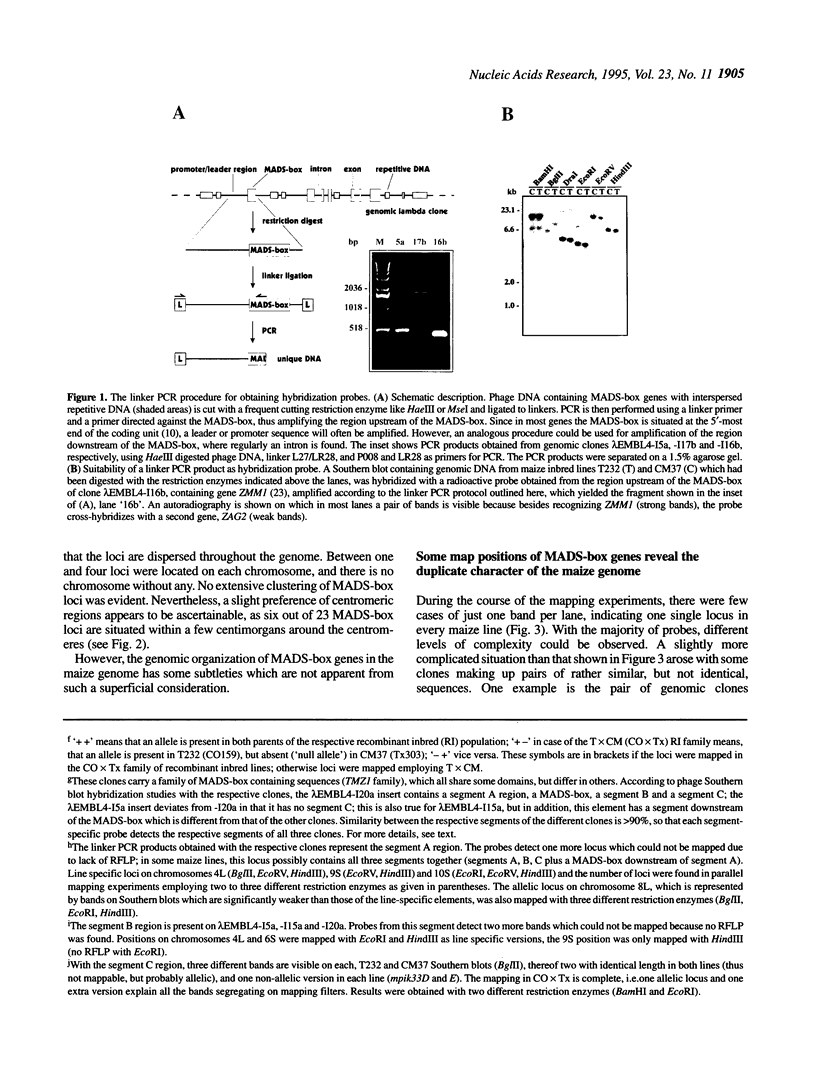
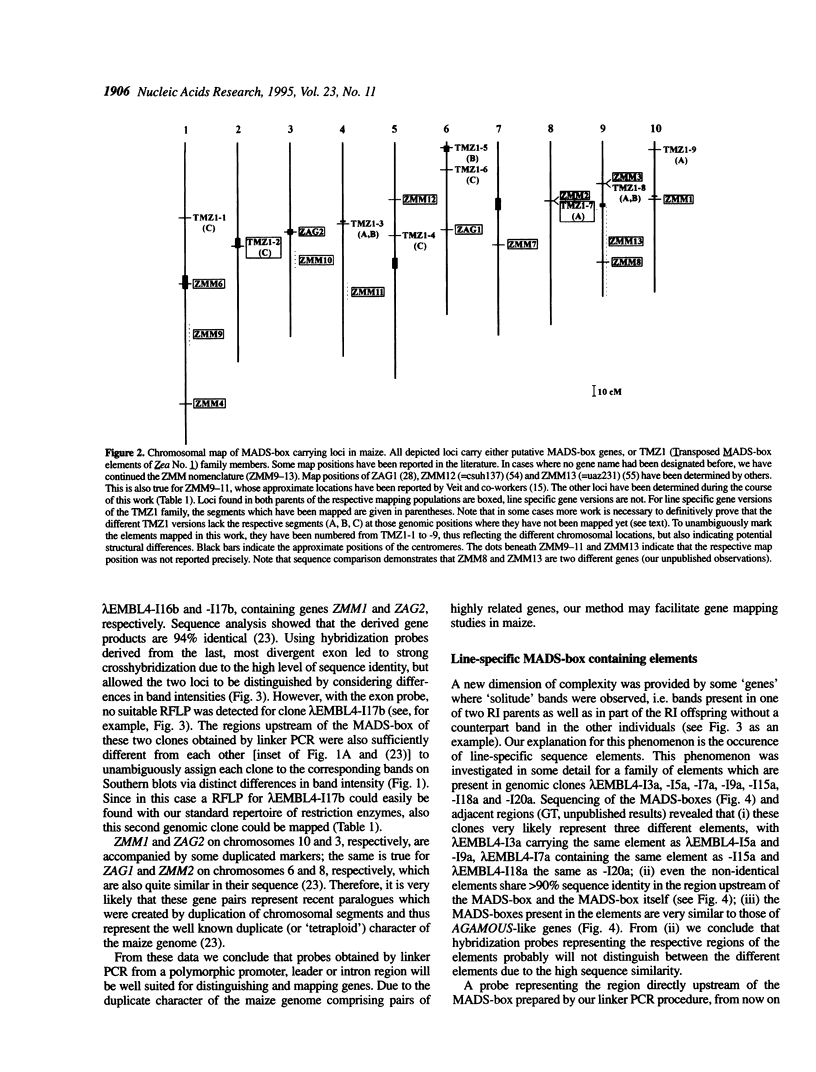
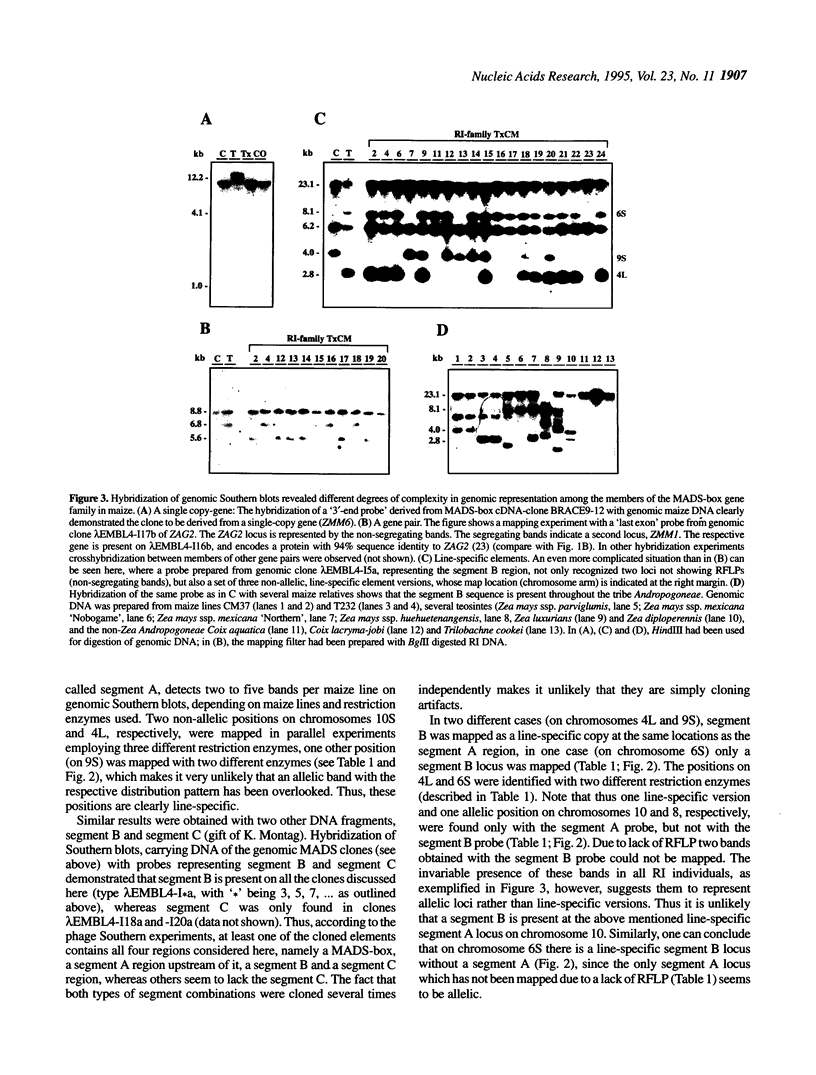
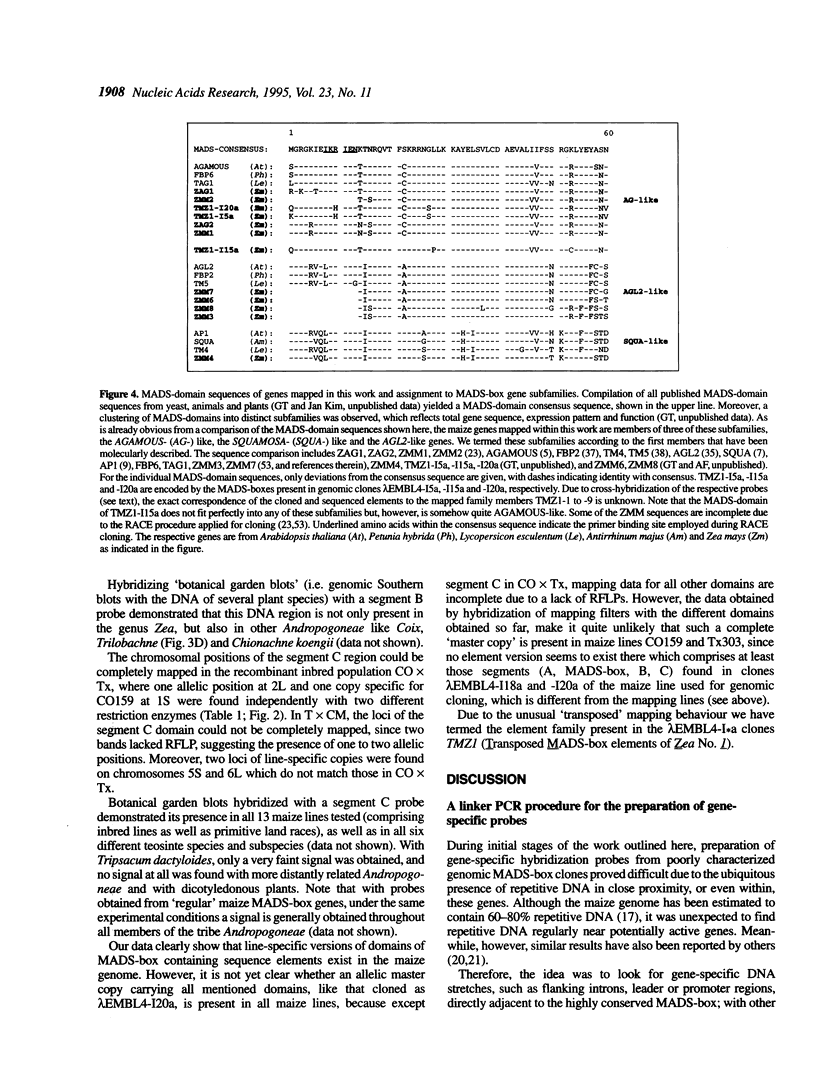
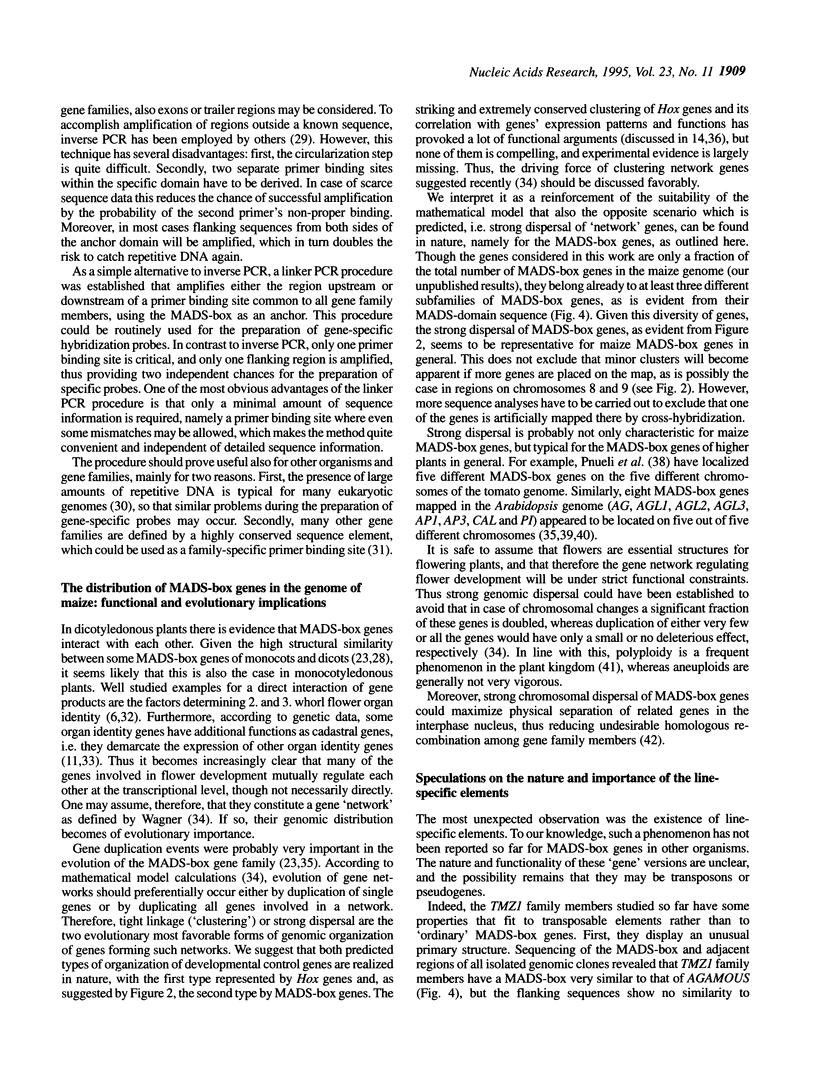
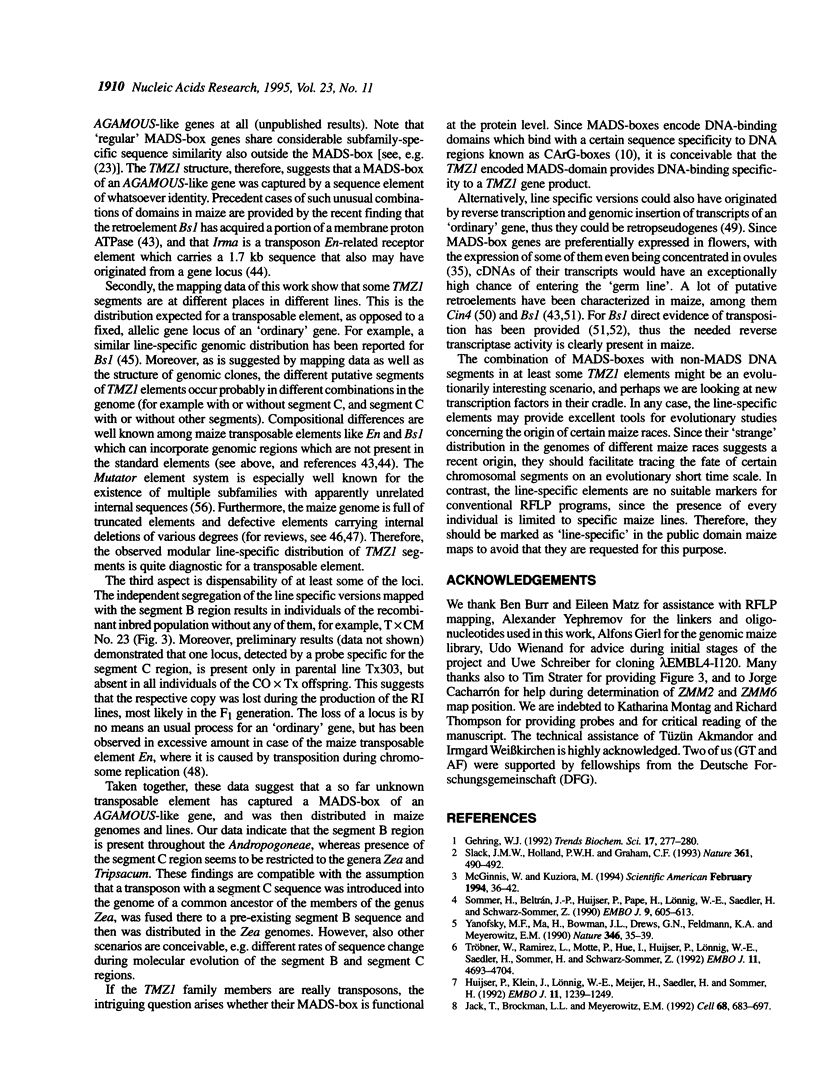

Images in this article
Selected References
These references are in PubMed. This may not be the complete list of references from this article.
- Angenent G. C., Franken J., Busscher M., Weiss D., van Tunen A. J. Co-suppression of the petunia homeotic gene fbp2 affects the identity of the generative meristem. Plant J. 1994 Jan;5(1):33–44. doi: 10.1046/j.1365-313x.1994.5010033.x. [DOI] [PubMed] [Google Scholar]
- Bennetzen J. L., Schrick K., Springer P. S., Brown W. E., SanMiguel P. Active maize genes are unmodified and flanked by diverse classes of modified, highly repetitive DNA. Genome. 1994 Aug;37(4):565–576. doi: 10.1139/g94-081. [DOI] [PubMed] [Google Scholar]
- Bradley D., Carpenter R., Sommer H., Hartley N., Coen E. Complementary floral homeotic phenotypes result from opposite orientations of a transposon at the plena locus of Antirrhinum. Cell. 1993 Jan 15;72(1):85–95. doi: 10.1016/0092-8674(93)90052-r. [DOI] [PubMed] [Google Scholar]
- Burr B., Burr F. A. Recombinant inbreds for molecular mapping in maize: theoretical and practical considerations. Trends Genet. 1991 Feb;7(2):55–60. doi: 10.1016/0168-9525(91)90232-F. [DOI] [PubMed] [Google Scholar]
- Burr B., Burr F. A., Thompson K. H., Albertson M. C., Stuber C. W. Gene mapping with recombinant inbreds in maize. Genetics. 1988 Mar;118(3):519–526. doi: 10.1093/genetics/118.3.519. [DOI] [PMC free article] [PubMed] [Google Scholar]
- Campbell I. D., Downing A. K. Building protein structure and function from modular units. Trends Biotechnol. 1994 May;12(5):168–172. doi: 10.1016/0167-7799(94)90078-7. [DOI] [PubMed] [Google Scholar]
- Charlesworth B., Sniegowski P., Stephan W. The evolutionary dynamics of repetitive DNA in eukaryotes. Nature. 1994 Sep 15;371(6494):215–220. doi: 10.1038/371215a0. [DOI] [PubMed] [Google Scholar]
- Dash S., Peterson P. A. Frequent loss of the En transposable element after excision and its relation to chromosome replication in maize (Zea mays L.). Genetics. 1994 Feb;136(2):653–671. doi: 10.1093/genetics/136.2.653. [DOI] [PMC free article] [PubMed] [Google Scholar]
- Davies B., Schwarz-Sommer Z. Control of floral organ identity by homeotic MADS-box transcription factors. Results Probl Cell Differ. 1994;20:235–258. doi: 10.1007/978-3-540-48037-2_11. [DOI] [PubMed] [Google Scholar]
- Duboule D., Morata G. Colinearity and functional hierarchy among genes of the homeotic complexes. Trends Genet. 1994 Oct;10(10):358–364. doi: 10.1016/0168-9525(94)90132-5. [DOI] [PubMed] [Google Scholar]
- Flavell R. B., Bennett M. D., Smith J. B., Smith D. B. Genome size and the proportion of repeated nucleotide sequence DNA in plants. Biochem Genet. 1974 Oct;12(4):257–269. doi: 10.1007/BF00485947. [DOI] [PubMed] [Google Scholar]
- Frohman M. A., Dush M. K., Martin G. R. Rapid production of full-length cDNAs from rare transcripts: amplification using a single gene-specific oligonucleotide primer. Proc Natl Acad Sci U S A. 1988 Dec;85(23):8998–9002. doi: 10.1073/pnas.85.23.8998. [DOI] [PMC free article] [PubMed] [Google Scholar]
- Gehring W. J. The homeobox in perspective. Trends Biochem Sci. 1992 Aug;17(8):277–280. doi: 10.1016/0968-0004(92)90434-b. [DOI] [PubMed] [Google Scholar]
- Gierl A., Saedler H., Peterson P. A. Maize transposable elements. Annu Rev Genet. 1989;23:71–85. doi: 10.1146/annurev.ge.23.120189.000443. [DOI] [PubMed] [Google Scholar]
- Goto K., Meyerowitz E. M. Function and regulation of the Arabidopsis floral homeotic gene PISTILLATA. Genes Dev. 1994 Jul 1;8(13):1548–1560. doi: 10.1101/gad.8.13.1548. [DOI] [PubMed] [Google Scholar]
- Gupta M., Shepherd N. S., Bertram I., Saedler H. Repetitive sequences and their organization on genomic clones of Zea mays. EMBO J. 1984 Jan;3(1):133–139. doi: 10.1002/j.1460-2075.1984.tb01773.x. [DOI] [PMC free article] [PubMed] [Google Scholar]
- Huijser P., Klein J., Lönnig W. E., Meijer H., Saedler H., Sommer H. Bracteomania, an inflorescence anomaly, is caused by the loss of function of the MADS-box gene squamosa in Antirrhinum majus. EMBO J. 1992 Apr;11(4):1239–1249. doi: 10.1002/j.1460-2075.1992.tb05168.x. [DOI] [PMC free article] [PubMed] [Google Scholar]
- Jack T., Brockman L. L., Meyerowitz E. M. The homeotic gene APETALA3 of Arabidopsis thaliana encodes a MADS box and is expressed in petals and stamens. Cell. 1992 Feb 21;68(4):683–697. doi: 10.1016/0092-8674(92)90144-2. [DOI] [PubMed] [Google Scholar]
- Jin Y. K., Bennetzen J. L. Integration and nonrandom mutation of a plasma membrane proton ATPase gene fragment within the Bs1 retroelement of maize. Plant Cell. 1994 Aug;6(8):1177–1186. doi: 10.1105/tpc.6.8.1177. [DOI] [PMC free article] [PubMed] [Google Scholar]
- Kempin S. A., Savidge B., Yanofsky M. F. Molecular basis of the cauliflower phenotype in Arabidopsis. Science. 1995 Jan 27;267(5197):522–525. doi: 10.1126/science.7824951. [DOI] [PubMed] [Google Scholar]
- Kenyon C. If birds can fly, why can't we? Homeotic genes and evolution. Cell. 1994 Jul 29;78(2):175–180. doi: 10.1016/0092-8674(94)90288-7. [DOI] [PubMed] [Google Scholar]
- Ma H. The unfolding drama of flower development: recent results from genetic and molecular analyses. Genes Dev. 1994 Apr 1;8(7):745–756. doi: 10.1101/gad.8.7.745. [DOI] [PubMed] [Google Scholar]
- Ma H., Yanofsky M. F., Meyerowitz E. M. AGL1-AGL6, an Arabidopsis gene family with similarity to floral homeotic and transcription factor genes. Genes Dev. 1991 Mar;5(3):484–495. doi: 10.1101/gad.5.3.484. [DOI] [PubMed] [Google Scholar]
- Mandel M. A., Gustafson-Brown C., Savidge B., Yanofsky M. F. Molecular characterization of the Arabidopsis floral homeotic gene APETALA1. Nature. 1992 Nov 19;360(6401):273–277. doi: 10.1038/360273a0. [DOI] [PubMed] [Google Scholar]
- Matsuo K., Clay O., Künzler P., Georgiev O., Urbánek P., Schaffner W. Short introns interrupting the Oct-2 POU domain may prevent recombination between POU family genes without interfering with potential POU domain 'shuffling' in evolution. Biol Chem Hoppe Seyler. 1994 Oct;375(10):675–683. doi: 10.1515/bchm3.1994.375.10.675. [DOI] [PubMed] [Google Scholar]
- Meyerowitz E. M. Flower development and evolution: new answers and new questions. Proc Natl Acad Sci U S A. 1994 Jun 21;91(13):5735–5737. doi: 10.1073/pnas.91.13.5735. [DOI] [PMC free article] [PubMed] [Google Scholar]
- Mottinger J. P., Johns M. A., Freeling M. Mutations of the Adh1 gene in maize following infection with barley stripe mosaic virus. Mol Gen Genet. 1984;195(1-2):367–369. doi: 10.1007/BF00332775. [DOI] [PubMed] [Google Scholar]
- Mueller P. R., Wold B. In vivo footprinting of a muscle specific enhancer by ligation mediated PCR. Science. 1989 Nov 10;246(4931):780–786. doi: 10.1126/science.2814500. [DOI] [PubMed] [Google Scholar]
- Muszynski M. G., Gierl A., Peterson P. A. Genetic and molecular analysis of a three-component transposable-element system in maize. Mol Gen Genet. 1993 Feb;237(1-2):105–112. doi: 10.1007/BF00282790. [DOI] [PubMed] [Google Scholar]
- Ochman H., Gerber A. S., Hartl D. L. Genetic applications of an inverse polymerase chain reaction. Genetics. 1988 Nov;120(3):621–623. doi: 10.1093/genetics/120.3.621. [DOI] [PMC free article] [PubMed] [Google Scholar]
- Pnueli L., Abu-Abeid M., Zamir D., Nacken W., Schwarz-Sommer Z., Lifschitz E. The MADS box gene family in tomato: temporal expression during floral development, conserved secondary structures and homology with homeotic genes from Antirrhinum and Arabidopsis. Plant J. 1991 Sep;1(2):255–266. [PubMed] [Google Scholar]
- Schmidt R. J., Veit B., Mandel M. A., Mena M., Hake S., Yanofsky M. F. Identification and molecular characterization of ZAG1, the maize homolog of the Arabidopsis floral homeotic gene AGAMOUS. Plant Cell. 1993 Jul;5(7):729–737. doi: 10.1105/tpc.5.7.729. [DOI] [PMC free article] [PubMed] [Google Scholar]
- Schwarz-Sommer Z., Huijser P., Nacken W., Saedler H., Sommer H. Genetic Control of Flower Development by Homeotic Genes in Antirrhinum majus. Science. 1990 Nov 16;250(4983):931–936. doi: 10.1126/science.250.4983.931. [DOI] [PubMed] [Google Scholar]
- Schwarz-Sommer Z., Leclercq L., Göbel E., Saedler H. Cin4, an insert altering the structure of the A1 gene in Zea mays, exhibits properties of nonviral retrotransposons. EMBO J. 1987 Dec 20;6(13):3873–3880. doi: 10.1002/j.1460-2075.1987.tb02727.x. [DOI] [PMC free article] [PubMed] [Google Scholar]
- Shen B., Carneiro N., Torres-Jerez I., Stevenson B., McCreery T., Helentjaris T., Baysdorfer C., Almira E., Ferl R. J., Habben J. E. Partial sequencing and mapping of clones from two maize cDNA libraries. Plant Mol Biol. 1994 Nov;26(4):1085–1101. doi: 10.1007/BF00040691. [DOI] [PubMed] [Google Scholar]
- Slack J. M., Holland P. W., Graham C. F. The zootype and the phylotypic stage. Nature. 1993 Feb 11;361(6412):490–492. doi: 10.1038/361490a0. [DOI] [PubMed] [Google Scholar]
- Sommer H., Beltrán J. P., Huijser P., Pape H., Lönnig W. E., Saedler H., Schwarz-Sommer Z. Deficiens, a homeotic gene involved in the control of flower morphogenesis in Antirrhinum majus: the protein shows homology to transcription factors. EMBO J. 1990 Mar;9(3):605–613. doi: 10.1002/j.1460-2075.1990.tb08152.x. [DOI] [PMC free article] [PubMed] [Google Scholar]
- Springer P. S., Edwards K. J., Bennetzen J. L. DNA class organization on maize Adh1 yeast artificial chromosomes. Proc Natl Acad Sci U S A. 1994 Feb 1;91(3):863–867. doi: 10.1073/pnas.91.3.863. [DOI] [PMC free article] [PubMed] [Google Scholar]
- Theissen G., Strater T., Fischer A., Saedler H. Structural characterization, chromosomal localization and phylogenetic evaluation of two pairs of AGAMOUS-like MADS-box genes from maize. Gene. 1995 Apr 24;156(2):155–166. doi: 10.1016/0378-1119(95)00020-7. [DOI] [PubMed] [Google Scholar]
- Tröbner W., Ramirez L., Motte P., Hue I., Huijser P., Lönnig W. E., Saedler H., Sommer H., Schwarz-Sommer Z. GLOBOSA: a homeotic gene which interacts with DEFICIENS in the control of Antirrhinum floral organogenesis. EMBO J. 1992 Dec;11(13):4693–4704. doi: 10.1002/j.1460-2075.1992.tb05574.x. [DOI] [PMC free article] [PubMed] [Google Scholar]
- Veit B., Schmidt R. J., Hake S., Yanofsky M. F. Maize Floral Development: New Genes and Old Mutants. Plant Cell. 1993 Oct;5(10):1205–1215. doi: 10.1105/tpc.5.10.1205. [DOI] [PMC free article] [PubMed] [Google Scholar]
- Wagner A. Evolution of gene networks by gene duplications: a mathematical model and its implications on genome organization. Proc Natl Acad Sci U S A. 1994 May 10;91(10):4387–4391. doi: 10.1073/pnas.91.10.4387. [DOI] [PMC free article] [PubMed] [Google Scholar]
- Weiner A. M., Deininger P. L., Efstratiadis A. Nonviral retroposons: genes, pseudogenes, and transposable elements generated by the reverse flow of genetic information. Annu Rev Biochem. 1986;55:631–661. doi: 10.1146/annurev.bi.55.070186.003215. [DOI] [PubMed] [Google Scholar]
- Yanofsky M. F., Ma H., Bowman J. L., Drews G. N., Feldmann K. A., Meyerowitz E. M. The protein encoded by the Arabidopsis homeotic gene agamous resembles transcription factors. Nature. 1990 Jul 5;346(6279):35–39. doi: 10.1038/346035a0. [DOI] [PubMed] [Google Scholar]




